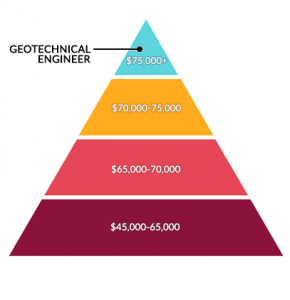The smart Trick of Geotheta That Nobody is Talking About
The Definitive Guide for Geotheta
Table of ContentsGetting My Geotheta To WorkGeotheta Things To Know Before You BuyGet This Report on GeothetaGeotheta - The Facts
They work together with civil engineers, architectural designers, engineers, and various other experts to integrate geotechnical considerations into the general project design and construction process. This calls for reliable team effort, sychronisation, and interaction to make certain that the geotechnical facets straighten with the job objectives and fulfill governing demands.Mining & Materials Engineering: Concepts of boring, penetration rates, and variables influencing the selection of exploration technique. Characteristics of explosives, firing systems and blast patterns. Blowing up methods in surface area and underground workings. Special blowing up methods at excavation perimeters. Vibration and sound control. Mechanical and constant approaches to fragmentation, consisting of longwall shearing and fullface boring.
Integrated analysis of fragmentation and comminution operations. Supplied by: Mining & Materials Engineering.
Everything about Geotheta
Bachelor's level programs in civil, geotechnical, geological, and ecological design commonly last 4 years and consist of basic education and learning courses in English, social scientific research, and the humanities, in addition to training courses in innovative maths, architectural geology, and liquid mineralogy. (https://packersmovers.activeboard.com/t67151553/how-to-connect-canon-mg3620-printer-to-computer/?ts=1722609175&direction=prev&page=last#lastPostAnchor)
Geotechnical design involves the assessment of the dirt and rock problems at a certain site, and their ramifications for the development of that website. As many frameworks count on the ground for assistance, it is without shock that a detailed understanding of the ground problems, and the viability of foundation systems, are crucial to the long-lasting stability and efficiency of the structure or structure.
Specialising in the examination of geological developments and ground behaviour, geotechnical engineers carry out clinical investigations and screening to understand the influence these geological developments may have on the style and construction of structure, civil and framework tasks. This expertise is important for the layout and construction of buildings, roadways, tunnels, dams, bridges, and water and sewer system.
The geotechnical group at Douglas Allies consistently talk to architects, design designers, programmers, and contractors to make referrals on style and development proposals to make sure that the built frameworks are accordingly made for the ground conditions. As an example, the design of footing systems needs to take into consideration the weight of the framework, the capacity of the ground to support that weight along with movement resistances and reliable building and construction.
The smart Trick of Geotheta That Nobody is Talking About
This task is greatly streamlined by the use our Douglas Map geospatial system that makes this information conveniently easily accessible in a simple to make use of web internet browser interface. A geotechnical engineer will certainly route the boring of boreholes and examination pits to accumulate soil and various other examples, and likewise assess surface area attributes and ground exposures to form a geotechnical version of the subsurface conditions.
Relying on the task kind and ground conditions ran into, lab screening might to name a few points examine strength, compressibility, sensitivity and/or permeability of soil and rock examples. Hereafter data is accumulated and collated, the results are utilized for a geotechnical version of the site, which is usually provided as areas throughout the site.

A geotechnical examination by nature can just assess the ground conditions at the locations pierced or dug deep into. All-natural variations in soil and rock problems can occur across a site and in between examination locations. It is consequently great technique that the geotechnical engineer be preserved throughout building of the project to give on-site verification that the ground conditions encountered follow the assumptions and guidance offered in the geotechnical examination record.
How Geotheta can Save You Time, Stress, and Money.
Geotechnical engineers use their in-depth knowledge of dirt and rock to evaluate risk and resolve troubles on varied framework projectsGeotechnical design is a specialist branch of civil design which takes a look at the behavior of planet materials and the application of soil and rock technicians. Tailings Engineer. As a geotechnical engineer, you will certainly examine the physical, mechanical and chemical homes of soil and rock in order to design foundations, keeping frameworks and earthworks
Geotechnical engineering is closely connected to and overlaps with, both design geology and ground engineering - https://packersmovers.activeboard.com/t67151553/how-to-connect-canon-mg3620-printer-to-computer/?ts=1722609175&direction=prev&page=last#lastPostAnchor. It's possible to be experts in geotechnics or benefit a geotechnical business yet be called a design rock hound or a ground engineer. As a geotechnical designer, you'll require to: construct and preserve connections with clients and other experts associated with the website, throughout each projectmaintain safety criteria on website bear in mind price ramifications when you make recommendationsstudy geological maps and airborne pictures from a series of resources and from different time periodsexamine construction prepares to see exactly how linked here possible they are based upon your understanding of the siteinvestigate dangers or geological dangers for the sitesearch for environmentally sensitive features, such as land fill begin to create factual and expository ground modelsplan field investigationsdrill and analyse examples of bedrock, soil, groundwater and added products oversee various other experts on sitesolve technological problems as they occur, such as unanticipated frameworks at drill sitesmonitor conditions throughout and after building to make sure frameworks are secure in the brief and long termadding data accumulated on website to your first researchcreating geotechnical computations, drawings, and 2 or three-dimensional computer system versions translating the datamaking referrals regarding the proposed use of the site
